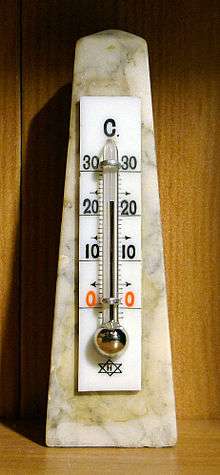Room temperature

Colloquially, room temperature is the range of air temperatures that most people prefer for indoor settings, which feel comfortable when wearing typical indoor clothing. As a medical definition, the range generally considered suitable for human occupancy is between 15 degrees Celsius (59 degrees Fahrenheit) and 25 °C (77 °F),[1] though human comfort can extend beyond this range depending on humidity, air circulation and other factors.[2] In certain fields, like science and engineering, and within a particular context, room temperature can mean different agreed-on ranges. In contrast, ambient temperature is the actual temperature of the air in any particular place, as measured by a thermometer. It may be very different from usual room temperature, for example an unheated room in winter.
Comfort levels
The American Heritage Dictionary of the English Language identifies room temperature as around 20 to 22 °C (68 to 72 °F),[3] and the Oxford English Dictionary claims that it is "conventionally taken as about 20 °C (68 °F)".[4]
Owing to variations in humidity and likely clothing, recommendations for summer and winter may vary; a suggested typical range for summer is 23 to 25.5 °C (73 to 78 °F), with that for winter being 20 to 23.5 °C (68 to 74 °F),[5] although by other considerations the maximum should be below 24 °C (75 °F) – and to avoid sick building syndrome, below 22 °C (72 °F).[5]
Some studies have suggested that thermal comfort preferences of men and women may differ significantly, with women on average preferring higher ambient temperatures.[6][7][8]
The World Health Organisation's standard for comfortable warmth is 18 °C (64 °F) for normal, healthy adults who are appropriately dressed. For those with respiratory problems or allergies, they recommend no less than 16 °C (61 °F), and for the sick, disabled, very old or very young, a minimum of 20 °C (68 °F).[9]
Definitions in science and industry
Temperature ranges are defined as room temperature for certain products and processes in industry, science, and consumer goods. For instance, for the shipping and storage of pharmaceuticals, the United States Pharmacopeia-National Formulary (USP-NF) defines controlled room temperature as between 20 to 25 °C (68 to 77 °F), with excursions between 15 to 30 °C (59 to 86 °F) allowed, provided the mean kinetic temperature does not exceed 25 °C (77 °F).[10] The European Pharmacopoeia defines it as being simply 15 to 25 °C (59 to 77 °F), and the Japanese Pharmacopeia defines "ordinary temperature" as 15 to 25 °C (59 to 77 °F), with room temperature being 1 to 30 °C (34 to 86 °F).[11][12]
Serving temperature of red wine
People traditionally serve red wine at room temperature. This practice dates from before central heating, when room temperature in wine-drinking countries was considerably lower than it is today, usually in the range between 15 °C (59 °F) and 18 °C (64 °F). The advice is therefore to serve the wine at, at most, about 18 °C (64 °F).[13]
See also
References
- ↑ Merriam Webster's Medical Dictionary. 2016. Archived from the original on 2010-04-10.
- ↑ "Archived copy". Archived from the original on 2017-09-20. Retrieved 2017-09-19.
- ↑ The American Heritage Dictionary of the English Language (5th ed.). 2014. Archived from the original on 2015-01-08.
- ↑ Oxford English Dictionary, Third Edition, November 2010), sub-entry at room.
- 1 2 Burroughs, H. E.; Hansen, Shirley (2011). Managing Indoor Air Quality. Fairmont Press. pp. 149–151. Archived from the original on 20 September 2014. Retrieved 25 December 2014.
- ↑ Beshir, MY; Ramsey, JD (March 1981). "Comparison between male and female subjective estimates of thermal effects and sensations". Applied Ergonomics. Retrieved Aug 30, 2018.
- ↑ Karjalainen, Sami (April 2007). "Gender differences in thermal comfort and use of thermostats in everyday thermal environments". Building and Environment. Retrieved Aug 30, 2018.
- ↑ Kingma, Boris; van Marken Lichtenbelt, Wouter (August 2015). "Energy consumption in buildings and female thermal demand". Nature Climate Change. Retrieved Aug 30, 2018.
- ↑ "BBC News Magazine: How warm is your home". Archived from the original on 2017-12-31.
- ↑ "General Chapter < 659> Packaging and Storage Requirements" (PDF). United States Pharmacopeia. 1 May 2017. Retrieved 2018-04-04.
- ↑ "What are the regulatory Definitions for "Ambient", "Room Temperature" and "Cold Chain"?". ECA Academy. 2 March 2017. Retrieved 2018-04-04.
- ↑ Shein-Chung Chow (2007). Statistical Design and Analysis of Stability Studies. Chapman & Hall/CRC Biostatistics Series. CRC Press. p. 7. ISBN 9781584889069. Retrieved 4 April 2018.
1.2.3.3 Definition of Room Temperature: According to the United States Pharmacopeia National Forumlary (USP-NF), the definition of room temperature is between 15 and 30 °C in the United States. However, in the EU, the room temperature is defined as being 15 to 25 °C, while in Japan, it is defined being 1 to 30 °C.
- ↑ Karen MacNeil (2015). The Wine Bible (revised second ed.). Workman Publishing. p. 130. ISBN 978-0-7611-8715-8.